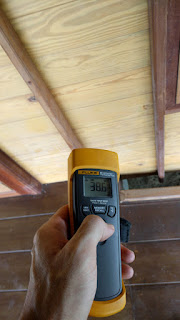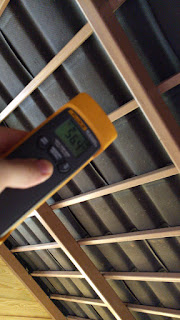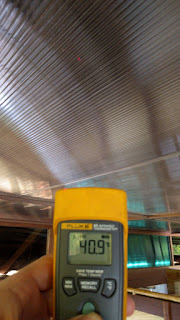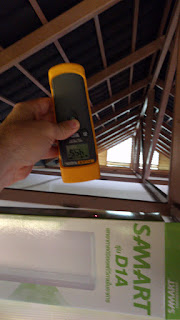Back in December, I brought the temperature sensor up into the attic to see how my low thermal mass airflow based attic cooling design worked out.
Well, based on our experiences recently living in BaanMae, I thought it would be worthwhile measuring the temperature again during this unusually-hot hot season. The following test was done on this last Saturday.
As noted previously, the low thermal mass design allows the heat in the house to flow out easily, so that sitting inside will be about the same temperature as sitting outside. Most houses try to keep out the heat of the day using insulation, not too many windows, and thick walls. But the cost comes in the night time, the same things that kept the heat out during the day keep the heat in at night.
The temperature these days is hovering around the hottest noontime temperature of the year for an unusually hot year. I measured the temperature both inside and outside the house to be about 38-39C (100-102F). (Yes, this is very hot.)
And the temperature on the inside of the uninsulated roof tiles measured in at over 56C (133F):
But the temperature of the thin polycarbonate separating the attic “wind tunnel” from the living area is only measuring around 41C (106F).
Note that this roof is almost 4 meters off the ground, so even ignoring the fact that there are roof tiles radiating almost 20C hotter than ambient in the attic, a 2-3C differential between floor and ceiling is pretty small actually. And then when you factor in the sun beating down on the roof tiles in the attic, it becomes clear that the only way that the ceiling material can be 2-3C hotter than 3 meters down while being 18C cooler than the roof tiles just 1-2m above is if most of the roof tile heat is being blown out of the attic by the free flowing wind tunnel effect up there.
I was curious what the temperature of the air in the attic was, so I left a random cardboard box up there for about 10 minutes and then measured the temperature:
The temperature of this box measured to 45.5C (114F). Since the roof tiles are heated to around 56C, they would naturally transfer some of that heat to the air in the attic. But since the air in the attic is naturally flowing in from the large west slatted window and out to the large east slatted window, the heated air will be blown outside and replaced by cooler (relatively) ambient air. Since this test was done close to the east side exhaust window, this means that the ambient 38C air is heated to about 45.5C before being blown back out of the attic. Eventually I will experiment with forced air flow (putting a large fan up there) to help this passive process along, which ought to help a bit on days where the air is unusually still. (There is normally a healthy breeze through the attic, as was the case today.)
One facet of the thermal transfer from roof to house that I didn’t consider when we designed the house was the conduction of heat through the steel beams. Even if we went the more traditional route of using insulation, this would still be an issue since the steel frame under the roof can conduct to the steel ceiling beams and down to the steel support columns.
But given the fact that the inside temperature is the same as the outside, it means that whatever remaining amount of heat not blown out with the breeze that is radiating or conducting down into the living area from the roof is easily radiated, conducted or convected out by the low thermal mass house design.
And as mentioned recently, our goal is to get a sprinkler system up on the roof to spray recycled water over the roof tiles during the hottest part of the day so the evaporation of the water can cool things down a bit also.
So for now, we successfully reached my initial target of making sure that the house doesn’t trap heat in but rather maintains a temperature very close to the ambient outside. Now I will begin to consider things like the sprinklers to naturally cool down the house in more active ways (i.e. evaporative cooling).
And the extended weather forecasts have the highs dropping to about 32-33C (about 90F) in mid May (which is only a few weeks away) and mostly not coming back up. With a fan blowing at you, my experience has shown me that 33C is much more comfortable than 38C.



